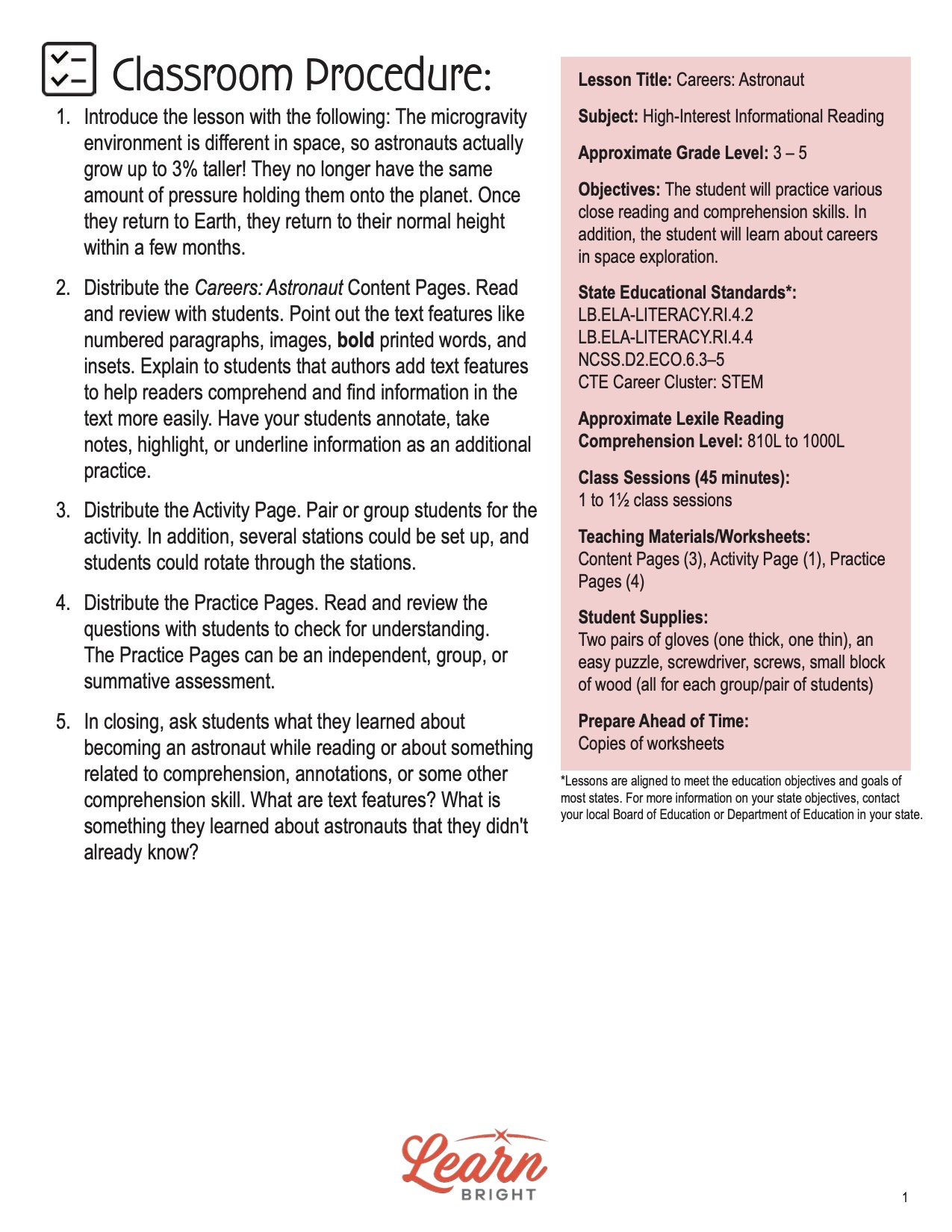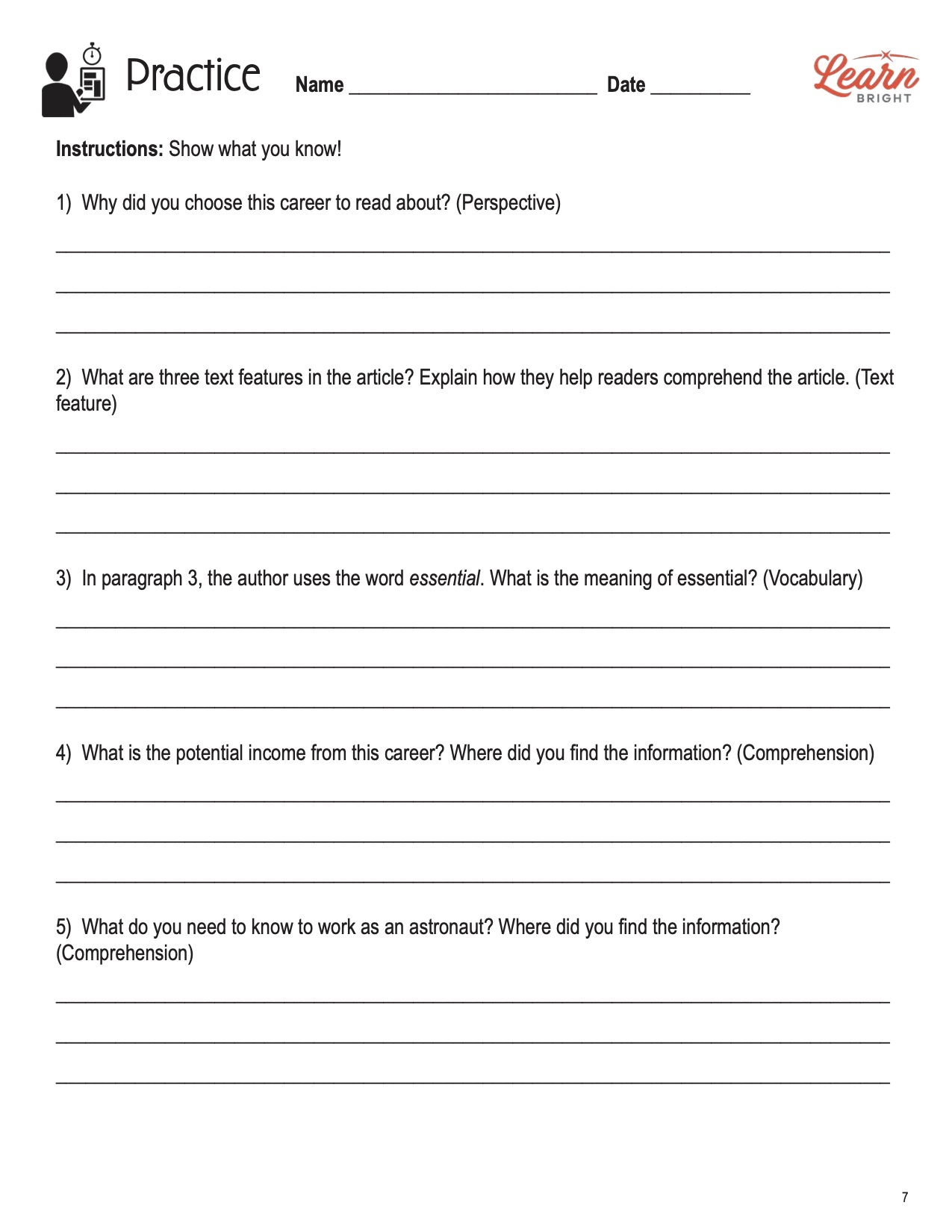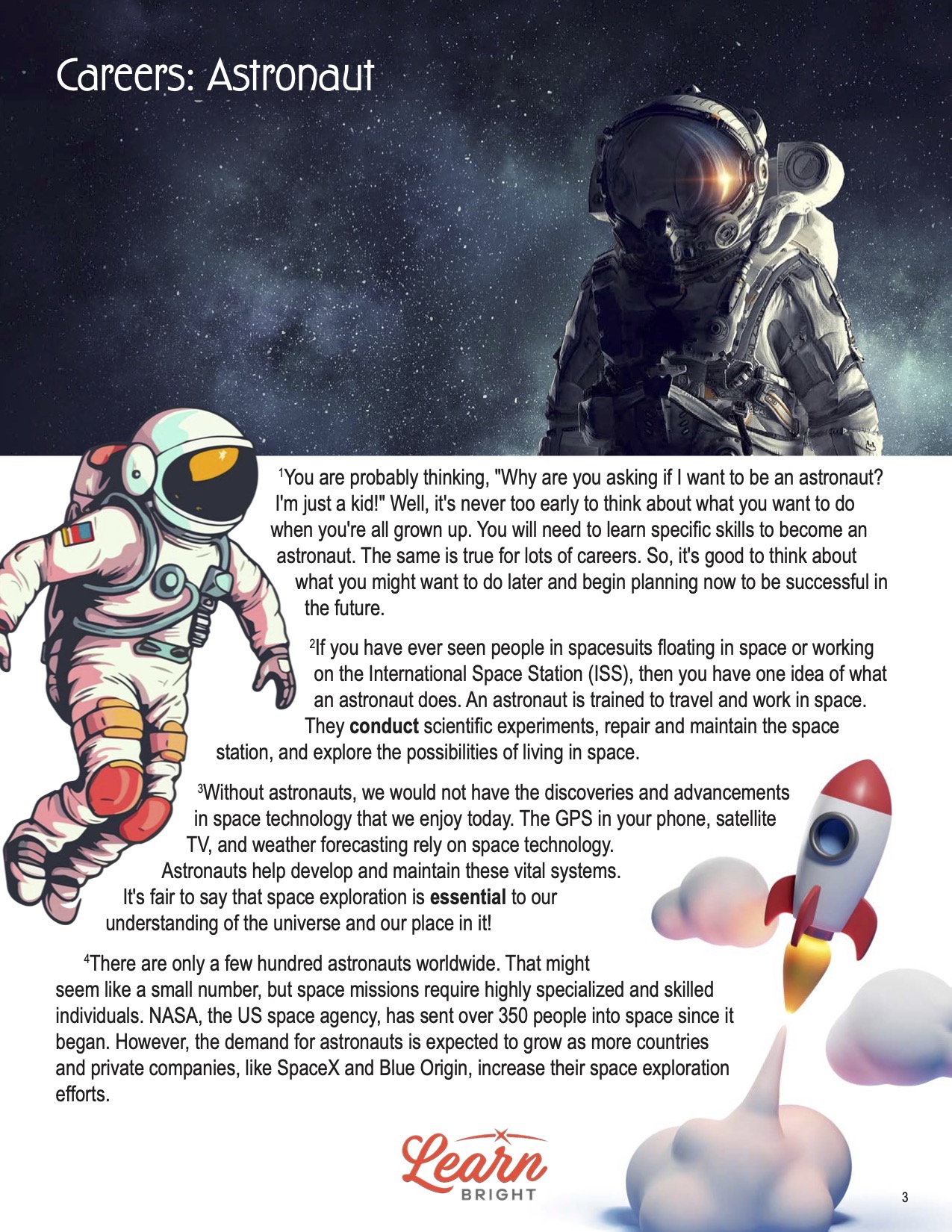Description
What our Careers: Astronaut lesson plan includes
Lesson Objectives and Overview: Careers: Astronaut is a high-interest reading comprehension lesson plan. As such, students will practice various close reading and comprehension skills. In addition, they will learn about careers in space exploration. This lesson is for students in 3rd grade, 4th grade, and 5th grade.
Classroom Procedure
Every lesson plan provides you with a classroom procedure page that outlines a step-by-step guide to follow. You do not have to follow the guide exactly. The guide helps you organize the lesson and details when to hand out worksheets. It also lists information in the yellow box that you might find useful. You will find the lesson objectives, state standards, and number of class sessions the lesson should take to complete in this area. In addition, it describes the supplies you will need as well as what and how you need to prepare beforehand. Supplies you’ll need for the activity include gloves (thick and thin pairs), simple jigsaw puzzles, screwdrivers, screws, and wood blocks.
Teacher Notes
The paragraph on this page gives you a little more information on the lesson overall and describes what you may want to focus your teaching on. It explains that you can teach this lesson in a whole-class setting or as an independent, small-group activity. The blank lines are available for you to write out any thoughts or ideas you have as you prepare.
CAREERS: ASTRONAUT LESSON PLAN CONTENT PAGES
Intro to Astronauts
The Careers: Astronaut lesson plan contains three content pages. You are probably thinking, “Why are you asking if I want to be an astronaut? I’m just a kid!” Well, it’s never too early to think about what you want to do when you’re all grown up. You will need to learn specific skills to become an astronaut. The same is true for lots of careers. So, it’s good to think about what you might want to do later and begin planning now to be successful in the future.
If you have ever seen people in spacesuits floating in space or working on the International Space Station (ISS), then you have one idea of what an astronaut does. An astronaut is trained to travel and work in space. They conduct scientific experiments, repair and maintain the space station, and explore the possibilities of living in space.
Without astronauts, we would not have the discoveries and advancements in space technology that we enjoy today. The GPS in your phone, satellite TV, and weather forecasting rely on space technology. Astronauts help develop and maintain these vital systems. It’s fair to say that space exploration is essential to our understanding of the universe and our place in it!
Logistics of the Career
There are only a few hundred astronauts worldwide. That might seem like a small number, but space missions require highly specialized and skilled individuals. NASA, the US space agency, has sent over 350 people into space since it began. However, the demand for astronauts is expected to grow as more countries and private companies, like SpaceX and Blue Origin, increase their space exploration efforts.
Depending on their role and experience, astronauts can earn around $104,000 annually. Highly experienced astronauts can earn much more, especially those who have flown multiple missions. Wages for astronauts will likely increase as space missions become more common and the need for their expertise grows.
Most astronauts work full-time. They spend months training on Earth for their missions, often working with scientists, engineers, and other specialists. In space, they work on experiments, maintain the spacecraft, and sometimes conduct spacewalks. If you like variety and exploring the unknown, being an astronaut may be your perfect career!
As an astronaut, you get to work in different environments—from training centers on Earth to floating around the Moon in space. On Earth, you practice using special equipment to prepare for your mission. You might even train in swimming pools that are deep enough to feel like you’re floating, just like you would in space! On the Moon, you could explore craters, collect rocks, and set up science experiments. And you would wear a special spacesuit to keep you safe and help you breathe. You could float around in space, inside a spaceship, or in a space station, because there’s no gravity! Plus, you would get to do cool experiments, take amazing pictures of Earth, and maybe even fix things outside the spaceship.
Becoming an Astronaut
What about education? The minimum requirement to become an astronaut is a bachelor’s degree in engineering, biological science, physical science, computer science, or mathematics. Many astronauts have advanced degrees, and some are medical doctors or pilots. The more education and experience you have, the more in demand you will be!
In addition to completing education, astronauts undergo rigorous training. Physical fitness training helps astronauts stay strong and healthy. They might run, lift weights, and do special exercises. Survival training is where they learn how to stay safe in emergencies, like if they land in the ocean or a desert after returning to Earth. They learn how to find food and water and stay warm.
But that’s not all—they still have more to do! During technical skills training, they practice using the tools and equipment they’ll need in space, like operating a spaceship’s controls or fixing broken things. Finally, they simulate space missions, practicing what it would be like to live and work in space. This might include using a giant pool to practice spacewalks or virtual reality to pretend they’re on the Moon. All this training helps astronauts get ready for anything they might face on their missions!
Astronauts are very important to our understanding of space and new technology. They conduct vital research, help develop new technologies, and inspire people worldwide. As an astronaut, you get to be at the front of the exploration while working in a field you are passionate about. That’s why you should reach for the stars and consider a career as an astronaut!
CAREERS: ASTRONAUT LESSON PLAN WORKSHEETS
The Careers: Astronaut lesson plan includes two worksheets: an activity worksheet and a practice worksheet. Each one will help students solidify their grasp of the material they learned throughout the lesson. You can refer to the classroom procedure guidelines to know when to hand out each worksheet.
DEXTERITY TRAINING ACTIVITY WORKSHEET
For this activity, students will get to practice wearing gloves to complete simple tasks. They will put on a thin pair of gloves first and complete a jigsaw puzzle. Then they will complete it while wearing thick gloves. They’ll do the same to put a screw into a block of wood. When they finish the tasks, they will answer the questions on the worksheet page.
REVIEW PRACTICE WORKSHEET
The practice worksheet requires students to answer a series of 10 questions. These questions all relate to the content pages, so students will need to refer to them often for the answers. In addition, each question provides which reading tool the question corresponds to, such as text feature, vocabulary, or comprehension.
Worksheet Answer Keys
At the end of the lesson plan document is an answer key for the practice worksheet. The correct answers are all in red to make it easier for you to compare them with students’ responses. If you choose to administer the lesson pages to your students via PDF, you will need to save a new file that omits these pages. Otherwise, you can simply print out the applicable pages and keep these as reference for yourself when grading assignments.









